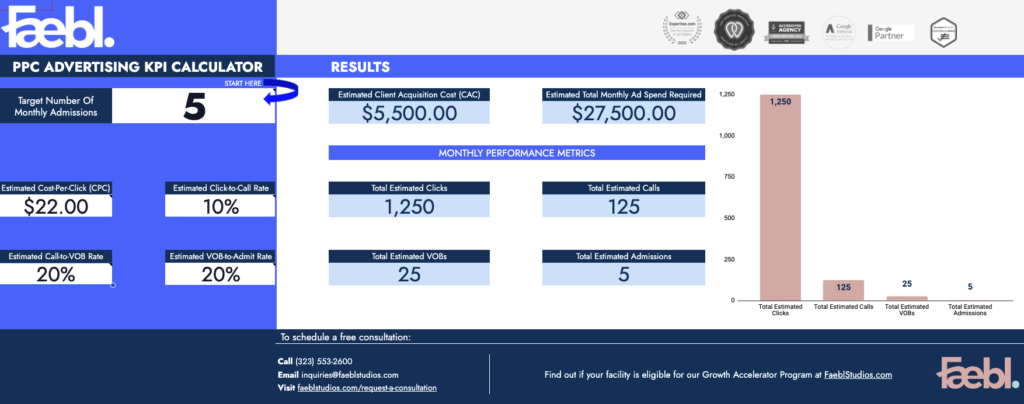Leading a successful substance use disorder (SUD) treatment facility requires a firm grasp on key performance indicators (KPIs). These invaluable metrics present a transparent snapshot of your center’s performance, equipping you with the necessary insights to steer your business towards growth and effectiveness. In the SUD treatment sector, these KPIs are indispensable in sustaining a steady inflow of clients, which we accomplish through diligent tracking of client acquisition metrics.
Diving into the Conversion Funnel: Crucial Metrics for Treatment Facilities
Your treatment center’s marketing performance can be significantly enhanced by a nuanced understanding of the conversion funnel. With these insights, you can pinpoint areas needing improvement, leading to an increased census and an uptick in clients served.
So, what KPIs should your treatment center prioritize?
Essential KPIs for Your Treatment Facility
While most marketing agencies will track click-through rates and conversion rates, there are intermediary metrics between the beginning and end of an ad campaign that provide detail into what areas of your business can be improved to acquire more clients and decrease your cost per acquisition.
Click-Through Rates (CTR)
CTR serves as a direct reflection of your ad campaign’s efficacy, providing insights into how well your ads align with potential clients’ interests. A high CTR indicates that your advertisements are successfully resonating with your audience, suggesting relevance and appeal. Conversely, a low rate may indicate it’s time for a campaign overhaul.
CTR is a critical component of Google’s Quality Score, a metric that affects how much you pay per click and your ad’s placement. A low CTR could negatively impact your Quality Score, leading to higher costs and less optimal ad placements on Google Search Results.
CTR can help determine if your ad copy is compelling and engaging. Ads that accurately reflect the search intent and align with the search queries tend to have higher CTRs.
By segmenting CTR by keyword, you can identify which keywords are performing well and which are not. This can guide your keyword optimization and bidding strategy.
Click-to-Call Rates
Click-to-Call rates give visibility into the performance and quality of the ad copy on your landing page or website. Does the copy accurately demonstrate value to the appropriate audience? Are you answering your audience’s questions? The Click-to-Call rate can provide valuable insight into the effectiveness of your call-to-action strategy.
If your Click-to-Call rate is below average, it may be worth taking a look at your landing page, website design, and copy. Consider whether they are designed with your ideal client in mind. You can also use A/B testing to improve your click-to-call conversions.
Call-to-Verification of Benefits (VOB)
After calling your admissions department, filling out a form on your website, or engaging with an admission’s representative through live chat, how many visitors are submitting a verification of benefits request?
A high volume of calls to your facility does not necessarily translate into success. Ensuring these calls lead to a verification of benefits (VOB) request is pivotal. While calls to your facility are great, they only really matter if they are potentially qualified calls that can result in an admission.
If there is a low qualified Call-to-VOB rate, investigate to discover why. Does your admissions team need to adjust their script? Are there elements of the program not emphasized enough on the calls? Is there a specific competitor your clients continue to go to apart from you?
It’s important to gauge the health of your calls based on:
- The share of first-time callers
- Average call duration
- The call source
For average call durations, calls that are more than a few minutes long may indicate a potentially qualified lead.
Tracking calls by the source is important as well. The addiction treatment industry has six main client acquisition channels:
- Organic (SEO) traffic
- Paid advertising
- Social media
- Professional referrals
- Business development
- Word-of-mouth referrals
Understanding where your calls are coming from can help you adjust your campaign accordingly.
At an absolute minimum, your SUD facility should be tracking qualified versus not qualified calls (i.e., insurance/ability to pay vs. no ability to pay). A more comprehensive approach would be to track how many calls were geographically, financially, or circumstantially qualified. This might include notes on insurance by carrier and type, inquiries by level(s) of care, inquiries by location, and inquiries by drug of choice.
All of these metrics can help determine what adjustments should be made to the targeting and content of your campaign in order to acquire your ideal clients and eliminate unnecessary spending.
VOB-to-Admit Rates
How many VOBs does it take to generate an admission? If the ratio is low, it’s important to understand whether that’s a result of unwillingness from the client or if the admissions team needs to work on closing prospective clients. VOB-to-Admit rates may vary based on your facility’s location, the payers you accept, and other factors.
Post-Admission KPIs
Finally, there are KPIs that your team should track post-admission that help guide your future marketing efforts. For example, it’s essential to understand the return on investment (ROI) of your marketing efforts to make informed decisions about your marketing budget and where your budget should be allocated.
To help understand your ROI, you should track: the Average Billing Value (ABV) of your clients, the average length of stay, and the Average Lifetime Value (LTV) of your clients.
If you offer multiple levels of care, make sure to have an understanding of these metrics for each of your programs.
How to Turn KPIs into Actionable Steps Toward Success
So, what does this mean for your facility? In our previous article, Google Ads Vs. Google SEO: What You Need To Know, we discussed how to budget for a paid advertising campaign using a few of the metrics above. To take it a step further, we’ve developed a PPC Advertising KPI Calculator you can use to determine your current customer acquisition cost and identify what areas need improvement.
The Formula
Target Admit of 1 / VOB-to-Admit rate / Call-to-VOB rate / Click-to-Call rate (CTC) / Average CPC = Cost per Acquisition (CAC)
You can use a different target admit number in order to determine what budget is necessary to acquire the targeted number of clients.
Example
Here’s a hypothetical example to illustrate how the formula works.
1 admit / 20% VOB-to-Admit rate / 20% Call-to-VOB rate / 10% Click-to-Call x $22 CPC = $5,500.00 Client Acquisition Cost
Knowing this will help you budget for your marketing efforts and decide which channels to use to acquire clients.
Conclusion
KPIs shouldn’t be scary, nor should they be burdensome. Rather, KPIs are the trusted numbers that will never lie to you, always letting you know the true state of your facility’s operations. Knowing what exactly these metrics mean and how they can be used to take action can lead to more clients and a decreased cost per acquisition. Are you ready to embrace KPIs?
Book a consultation with Faebl Studios today to improve your facility’s tracking and performance.
Resource: Click here to access the PPC Advertising KPI Calculator for SUD Treatment Facilities




